Yongqiang Yang
Serving Large Language Models on Huawei CloudMatrix384
Jun 15, 2025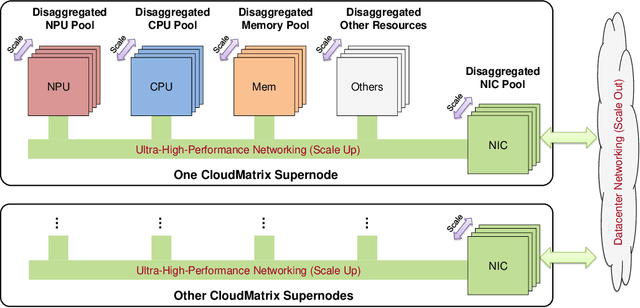

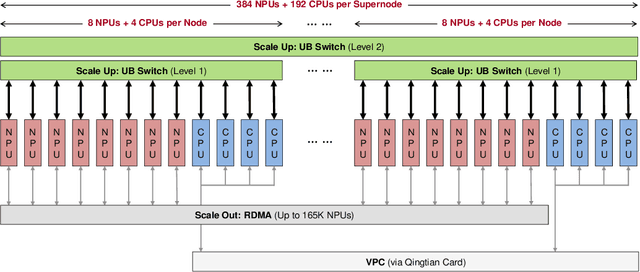
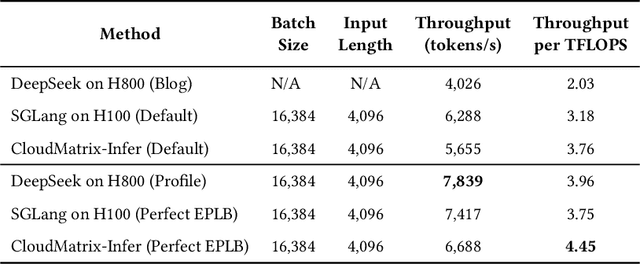
Abstract:The rapid evolution of large language models (LLMs), driven by growing parameter scales, adoption of mixture-of-experts (MoE) architectures, and expanding context lengths, imposes unprecedented demands on AI infrastructure. Traditional AI clusters face limitations in compute intensity, memory bandwidth, inter-chip communication, and latency, compounded by variable workloads and strict service-level objectives. Addressing these issues requires fundamentally redesigned hardware-software integration. This paper introduces Huawei CloudMatrix, a next-generation AI datacenter architecture, realized in the production-grade CloudMatrix384 supernode. It integrates 384 Ascend 910C NPUs and 192 Kunpeng CPUs interconnected via an ultra-high-bandwidth Unified Bus (UB) network, enabling direct all-to-all communication and dynamic pooling of resources. These features optimize performance for communication-intensive operations, such as large-scale MoE expert parallelism and distributed key-value cache access. To fully leverage CloudMatrix384, we propose CloudMatrix-Infer, an advanced LLM serving solution incorporating three core innovations: a peer-to-peer serving architecture that independently scales prefill, decode, and caching; a large-scale expert parallelism strategy supporting EP320 via efficient UB-based token dispatch; and hardware-aware optimizations including specialized operators, microbatch-based pipelining, and INT8 quantization. Evaluation with the DeepSeek-R1 model shows CloudMatrix-Infer achieves state-of-the-art efficiency: prefill throughput of 6,688 tokens/s per NPU and decode throughput of 1,943 tokens/s per NPU (<50 ms TPOT). It effectively balances throughput and latency, sustaining 538 tokens/s even under stringent 15 ms latency constraints, while INT8 quantization maintains model accuracy across benchmarks.
FaultProfIT: Hierarchical Fault Profiling of Incident Tickets in Large-scale Cloud Systems
Feb 27, 2024Abstract:Postmortem analysis is essential in the management of incidents within cloud systems, which provides valuable insights to improve system's reliability and robustness. At CloudA, fault pattern profiling is performed during the postmortem phase, which involves the classification of incidents' faults into unique categories, referred to as fault pattern. By aggregating and analyzing these fault patterns, engineers can discern common faults, vulnerable components and emerging fault trends. However, this process is currently conducted by manual labeling, which has inherent drawbacks. On the one hand, the sheer volume of incidents means only the most severe ones are analyzed, causing a skewed overview of fault patterns. On the other hand, the complexity of the task demands extensive domain knowledge, which leads to errors and inconsistencies. To address these limitations, we propose an automated approach, named FaultProfIT, for Fault pattern Profiling of Incident Tickets. It leverages hierarchy-guided contrastive learning to train a hierarchy-aware incident encoder and predicts fault patterns with enhanced incident representations. We evaluate FaultProfIT using the production incidents from CloudA. The results demonstrate that FaultProfIT outperforms state-of-the-art methods. Our ablation study and analysis also verify the effectiveness of hierarchy-guided contrastive learning. Additionally, we have deployed FaultProfIT at CloudA for six months. To date, FaultProfIT has analyzed 10,000+ incidents from 30+ cloud services, successfully revealing several fault trends that have informed system improvements.
Alioth: A Machine Learning Based Interference-Aware Performance Monitor for Multi-Tenancy Applications in Public Cloud
Jul 18, 2023Abstract:Multi-tenancy in public clouds may lead to co-location interference on shared resources, which possibly results in performance degradation of cloud applications. Cloud providers want to know when such events happen and how serious the degradation is, to perform interference-aware migrations and alleviate the problem. However, virtual machines (VM) in Infrastructure-as-a-Service public clouds are black-boxes to providers, where application-level performance information cannot be acquired. This makes performance monitoring intensely challenging as cloud providers can only rely on low-level metrics such as CPU usage and hardware counters. We propose a novel machine learning framework, Alioth, to monitor the performance degradation of cloud applications. To feed the data-hungry models, we first elaborate interference generators and conduct comprehensive co-location experiments on a testbed to build Alioth-dataset which reflects the complexity and dynamicity in real-world scenarios. Then we construct Alioth by (1) augmenting features via recovering low-level metrics under no interference using denoising auto-encoders, (2) devising a transfer learning model based on domain adaptation neural network to make models generalize on test cases unseen in offline training, and (3) developing a SHAP explainer to automate feature selection and enhance model interpretability. Experiments show that Alioth achieves an average mean absolute error of 5.29% offline and 10.8% when testing on applications unseen in the training stage, outperforming the baseline methods. Alioth is also robust in signaling quality-of-service violation under dynamicity. Finally, we demonstrate a possible application of Alioth's interpretability, providing insights to benefit the decision-making of cloud operators. The dataset and code of Alioth have been released on GitHub.
Audience Expansion for Multi-show Release Based on an Edge-prompted Heterogeneous Graph Network
Apr 08, 2023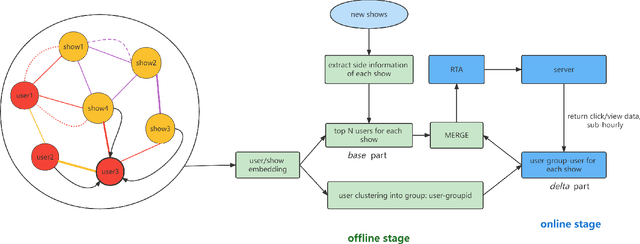

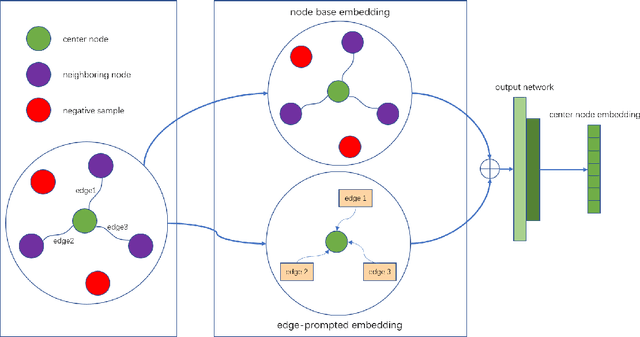

Abstract:In the user targeting and expanding of new shows on a video platform, the key point is how their embeddings are generated. It's supposed to be personalized from the perspective of both users and shows. Furthermore, the pursue of both instant (click) and long-time (view time) rewards, and the cold-start problem for new shows bring additional challenges. Such a problem is suitable for processing by heterogeneous graph models, because of the natural graph structure of data. But real-world networks usually have billions of nodes and various types of edges. Few existing methods focus on handling large-scale data and exploiting different types of edges, especially the latter. In this paper, we propose a two-stage audience expansion scheme based on an edge-prompted heterogeneous graph network which can take different double-sided interactions and features into account. In the offline stage, to construct the graph, user IDs and specific side information combinations of the shows are chosen to be the nodes, and click/co-click relations and view time are used to build the edges. Embeddings and clustered user groups are then calculated. When new shows arrive, their embeddings and subsequent matching users can be produced within a consistent space. In the online stage, posterior data including click/view users are employed as seeds to look for similar users. The results on the public datasets and our billion-scale data demonstrate the accuracy and efficiency of our approach.
Heterogeneous Anomaly Detection for Software Systems via Semi-supervised Cross-modal Attention
Feb 14, 2023Abstract:Prompt and accurate detection of system anomalies is essential to ensure the reliability of software systems. Unlike manual efforts that exploit all available run-time information, existing approaches usually leverage only a single type of monitoring data (often logs or metrics) or fail to make effective use of the joint information among different types of data. Consequently, many false predictions occur. To better understand the manifestations of system anomalies, we conduct a systematical study on a large amount of heterogeneous data, i.e., logs and metrics. Our study demonstrates that logs and metrics can manifest system anomalies collaboratively and complementarily, and neither of them only is sufficient. Thus, integrating heterogeneous data can help recover the complete picture of a system's health status. In this context, we propose Hades, the first end-to-end semi-supervised approach to effectively identify system anomalies based on heterogeneous data. Our approach employs a hierarchical architecture to learn a global representation of the system status by fusing log semantics and metric patterns. It captures discriminative features and meaningful interactions from heterogeneous data via a cross-modal attention module, trained in a semi-supervised manner. We evaluate Hades extensively on large-scale simulated data and datasets from Huawei Cloud. The experimental results present the effectiveness of our model in detecting system anomalies. We also release the code and the annotated dataset for replication and future research.
Graph-based Incident Aggregation for Large-Scale Online Service Systems
Aug 27, 2021


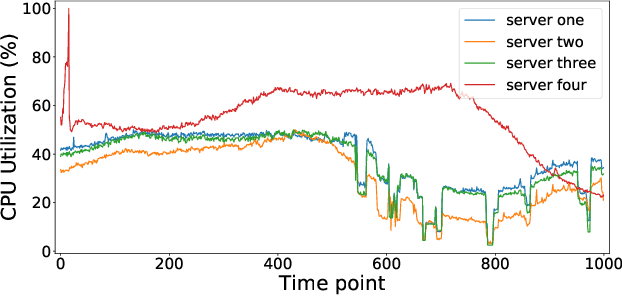
Abstract:As online service systems continue to grow in terms of complexity and volume, how service incidents are managed will significantly impact company revenue and user trust. Due to the cascading effect, cloud failures often come with an overwhelming number of incidents from dependent services and devices. To pursue efficient incident management, related incidents should be quickly aggregated to narrow down the problem scope. To this end, in this paper, we propose GRLIA, an incident aggregation framework based on graph representation learning over the cascading graph of cloud failures. A representation vector is learned for each unique type of incident in an unsupervised and unified manner, which is able to simultaneously encode the topological and temporal correlations among incidents. Thus, it can be easily employed for online incident aggregation. In particular, to learn the correlations more accurately, we try to recover the complete scope of failures' cascading impact by leveraging fine-grained system monitoring data, i.e., Key Performance Indicators (KPIs). The proposed framework is evaluated with real-world incident data collected from a large-scale online service system of Huawei Cloud. The experimental results demonstrate that GRLIA is effective and outperforms existing methods. Furthermore, our framework has been successfully deployed in industrial practice.
 Add to Chrome
Add to Chrome Add to Firefox
Add to Firefox Add to Edge
Add to Edge